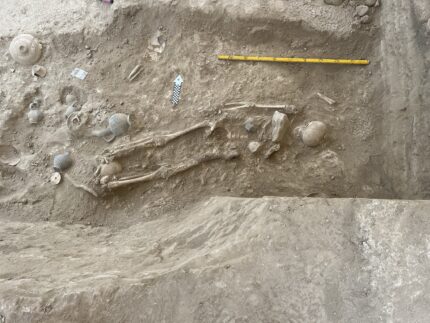 Bronze Age tombs so rich in luxurious grave goods they likely belonged to the rulers of the city have been discovered in the ancient city of Dromolaxia Vizatzia on the southeastern coast of Cyprus. The opulent funerary furnishings mark these tombs as among the richest ever found from the Mediterranean Bronze Age.
Bronze Age tombs so rich in luxurious grave goods they likely belonged to the rulers of the city have been discovered in the ancient city of Dromolaxia Vizatzia on the southeastern coast of Cyprus. The opulent funerary furnishings mark these tombs as among the richest ever found from the Mediterranean Bronze Age.
The tombs were found in Area A, a cemetery just outside the city 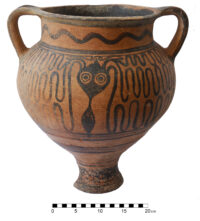 perimeter. Broken pottery had been churned up by ploughs during previous agricultural work, spurring archaeologists to scan the site with magnetometers which can relay images of objects up to six feet beneath the surface of the soil. The magnetometer map revealed large cavities three to six feet under the surface.
perimeter. Broken pottery had been churned up by ploughs during previous agricultural work, spurring archaeologists to scan the site with magnetometers which can relay images of objects up to six feet beneath the surface of the soil. The magnetometer map revealed large cavities three to six feet under the surface.
The excavation unearthed three chamber tombs dating to the 14th century B.C. One had been looted, probably in the 19th century, suffering extensive damage to the grave goods and the human remains. The scattered bones were collected for conservation and study. Archaeologists were also able to recovered some jewelry and sherds from pottery imported from the Mycenean cultures of the Aegean, Egypt and Anatolia.
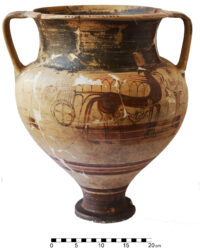 The other two tombs had never been looted, although their chambers had collapsed in antiquity. Between the two tombs, archaeologists found more than 500 artifacts, including local pottery, jewelry, daggers, knives, spearheads and imported pottery and decorative ornaments from the Aegean, Anatolia, Egypt and the Levant. The imported luxury items came from even greater distances too. There was amber from the Baltic Sea, for example, lapis lazuli from Afghanistan and deep red carnelian from India.
The other two tombs had never been looted, although their chambers had collapsed in antiquity. Between the two tombs, archaeologists found more than 500 artifacts, including local pottery, jewelry, daggers, knives, spearheads and imported pottery and decorative ornaments from the Aegean, Anatolia, Egypt and the Levant. The imported luxury items came from even greater distances too. There was amber from the Baltic Sea, for example, lapis lazuli from Afghanistan and deep red carnelian from India.
The several well-preserved skeletons in the tombs include that of a woman surrounded by dozens of ceramic vessels, jewellery and a round bronze mirror that was once polished. A one-year-old child with a ceramic toy lay beside her.
“Several individuals, both men and women, wore diadems, and some had necklaces with pendants of the highest quality, probably made in Egypt during the 18th dynasty at the time of such pharaohs as Thutmos III and Amenophis IV (Akhenaten) and his wife Nefertiti.”
Embossed images of bulls, gazelles, lions and flowers adorn the diadems. Most of the ceramic vessels came from what we now call Greece, and the expedition also found pots from Turkey, Syria, Palestine and Egypt.
The grave goods also included bronze weapons, some inlaid with ivory, and a gold-framed seal made of the hard mineral haematite with inscriptions of gods and rulers.
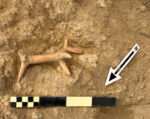
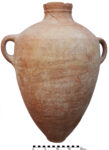 Dromolaxia Vizatzia was a Late Bronze Age harbor city on the shores of the Larnaca Salt Lake that flourished from around 1630 to 1150 B.C. Mines in the nearby Troodos Mountains produced copper ore and between 1500 and 1300 B.C., the city prospered as a major center of copper refining and export. Little is known about the city’s form of government, so it’s hard to say whether the people interred in the chamber tombs were royalty, exactly, but they were certainly part of the governing structure.
Dromolaxia Vizatzia was a Late Bronze Age harbor city on the shores of the Larnaca Salt Lake that flourished from around 1630 to 1150 B.C. Mines in the nearby Troodos Mountains produced copper ore and between 1500 and 1300 B.C., the city prospered as a major center of copper refining and export. Little is known about the city’s form of government, so it’s hard to say whether the people interred in the chamber tombs were royalty, exactly, but they were certainly part of the governing structure.
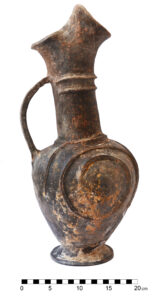
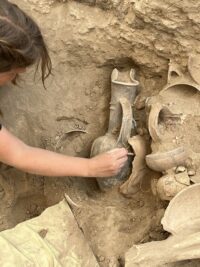
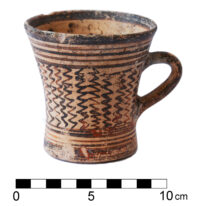
“Dromolaxia Vizatzia” (Vyzakia/ Βυζακιά?) was (were?) found a few hundred meters West of Hala Sultan Tekke, likewise a Bronze Age site, on the west bank of Larnaca Salt Lake. Notably, its harbour is said to have been accessible from the sea by two shipping channels.
Indeed, it seems as if trade played an important role . The (Eastern) Mediterranean Bronze Age knows nearby –en route to Rhodes– the late 14th century BC “Uluburun Shipwreck”. Here the cargo list as described by Pulak (1998) reveals:
———–
## Copper and tin ingots: Raw copper cargo totaling ten tons, consisting of a total of 354 ingots of the oxhide ingot type (rectangular with handholds extending from each corner). Out of the total number of ingots at least 31 unique two-handled ingots were identified that were most likely shaped this way to assist the process of loading ingots onto specially designed saddles or harnesses for ease of transport over long distances by pack animals. 121 copper bun and oval ingots. The oxhide ingots were originally stowed in 4 distinct rows across the ship’s hold, which either slipped down the slope after the ship sank or shifted as the hull settled under the weight of the cargo. Lead-isotope analysis indicates that most or all of the copper was sourced in Cyprus. Approximately one ton of tin (when alloyed with the copper would make about 11 tons of bronze). The tin ingots were oxhide and bun shaped. In 2022 one third of the tin was found to come from the Mušiston mine in Uzbekistan. The other share likely came from the Kestel Mine in Turkey’s Taurus Mountains. The ingots suffer from corrosion and likely contamination. However, unlike some other tin ingots from the eastern Mediterranean, they do not fit the profile of tin from Cornwall, and generally compare to ores from Sardinia.
## Canaanite jars and Pistacia resin: At least 149 Canaanite jars (widely found in Greece, Cyprus, Syria-Palestine, and Egypt). Jars are categorized as the northern type and were most likely made somewhere in the northern part of modern-day Israel. One jar filled was with glass beads, many filled with olives, but the majority contained a substance known as Pistacia (terebinth) resin, an ancient type of turpentine. Recent clay fabric analyses of Canaanite jar sherds from the 18th Dynasty site of Tel el Amarna have produced a specific clay fabric designation, and it is seemingly the same as that from the Uluburun shipwreck, of a type that is exclusively associated in Amarna with transporting Pistacia resin.
## Glass ingots: Approximately 175 glass ingots of cobalt blue, turquoise, and lavender were found (earliest intact glass ingots known). Chemical composition of cobalt blue glass ingots matches those of contemporary Egyptian core-formed vessels and Mycenaean pendant beads, which suggests a common source.
## Miscellaneous cargo: Logs of blackwood from Africa (referred to as ebony by the Egyptians), Ivory in the form of whole and partial hippopotamus and elephant tusks, More than a dozen hippopotamus teeth, Tortoise carapaces (upper shells), Murex opercula (possible ingredient for incense), Ostrich eggshells, Cypriot pottery, Cypriot oil lamps, Bronze and copper vessels (four faience drinking cups shaped as rams’ heads and one shaped as a woman’s head), Two duck-shaped ivory cosmetics boxes, Ivory cosmetics or unguent spoon, Trumpet, More than two dozen sea-shell rings, Beads of amber (Baltic origin), Agate, Carnelian, Quartz, Gold, Faience, Glass
## Jewelry, gold, and silver: Collection of usable and scrap gold and silver Canaanite jewelry, Among the 37 gold pieces are: pectorals, medallions, pendants, beads, a small ring ingot, and an assortment of fragments, Biconical chalice (largest gold object from wreck), Egyptian objects of gold, electrum, silver, and steatite (soap stone), Gold scarab inscribed with the name of Nefertiti, Bronze female figurine (head, neck, hands, and feet covered in sheet gold)
## Weapons and tools: Arrowheads, Spearheads, Maces, Daggers, Lugged shaft-hole axe, A single armor scale of Near Eastern type, Four swords (Canaanite, Mycenaean, and Italian(?) types), Large number of tools: sickles, awls, drill bits, a saw, a pair of tongs, chisels, a ploughshare, whetstones, and adzes, Axes, ceremonial axe made of green volcanic stone that originates from area Bulgaria, A small folding boxwood writing-tablet was found with partially extant ivory hinges. It likely would have had wax writing surfaces.
## Pan-balance weights: 19 zoomorphic weights (Uluburun weight assemblage is one of the largest and most complete groups of contemporaneous Late Bronze Age weights), 120 geometric-shaped weights.
## Edibles: Almonds, Pine nuts, Figs, Olives, Grapes, Safflower, Black cumin, Sumac, Coriander, Whole pomegranates, A few grains of charred wheat and barley
A trivial comment perhaps, but I would gladly purchase a mug of the pattern shown in the final image here.